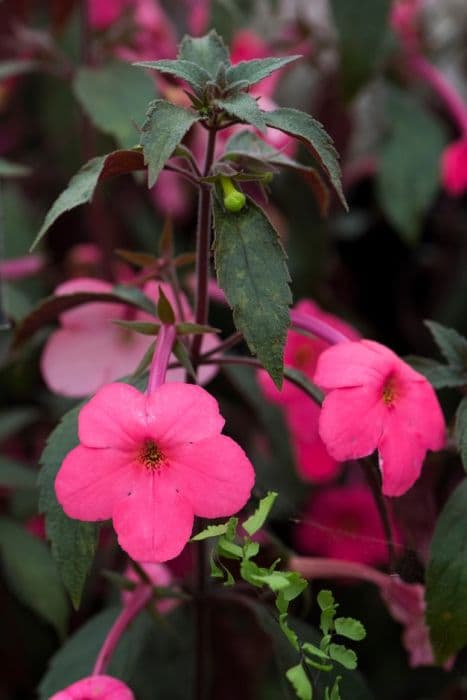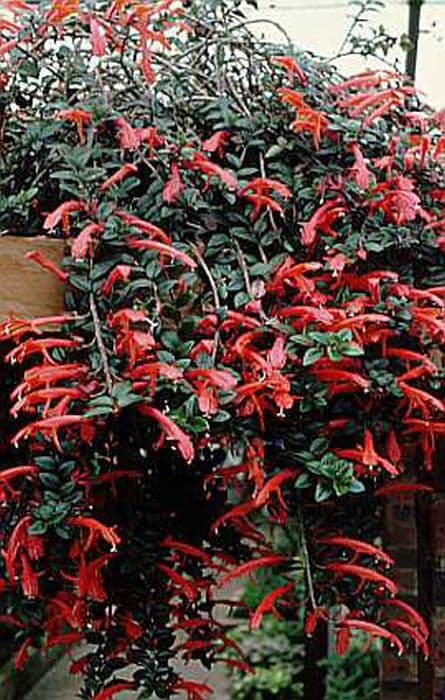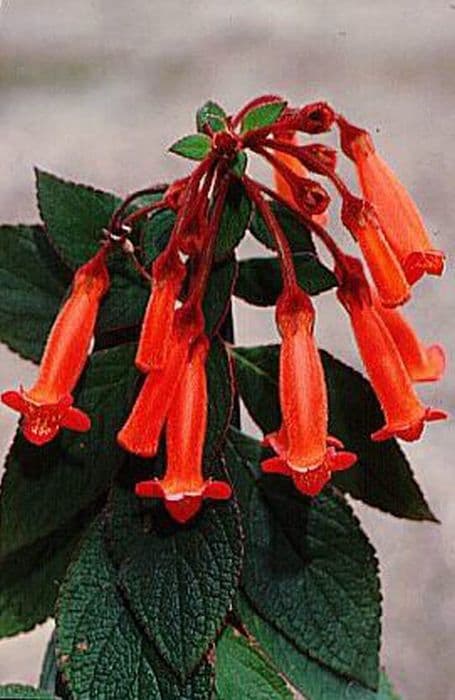Cape Primrose Streptocarpus 'Olivia'

ABOUT
The Streptocarpus 'Olivia', commonly known as Cape Primrose, is a striking flowering plant notable for its lush, velvety foliage and vibrant blooms. The leaves are elongated and typically grow in a rosette formation, presenting a deep green color with a soft, sometimes fuzzy texture that is pleasant to the touch. Flowers emerge on slender stems that rise above the foliage, showcasing the plant's ornate blossoms that come in a soothing shade of lavender or purple with intricate patterns and marking. The petals are often delicately ruffled, adding to their charm and delicate appearance, which makes them a favorite among houseplant enthusiasts. Cape Primrose blooms are distinctive, with their throats often displaying a contrasting color or pattern that draws the eye and enhances their overall allure.
About this plant
 Names
NamesFamily
Gesneriaceae
Synonyms
Cape Primrose, African Violet
Common names
Streptocarpus 'Olivia'
 Toxicity
ToxicityTo humans
The Cape primrose, which is the common name for Streptocarpus 'Olivia', is generally considered non-toxic to humans. As such, it does not typically cause poisoning or adverse symptoms if ingested in small quantities. However, it's always advisable to be cautious with plant ingestion, particularly with children, as individual reactions can vary and some people might have sensitivities or allergies to certain plant species.
To pets
The Cape primrose is also generally recognized as non-toxic to pets. This means that ingestion of this plant, in normal amounts, is unlikely to cause serious harm to animals such as cats and dogs. Symptoms of poisoning are not typically associated with this plant. Nonetheless, it's always a good idea to discourage pets from eating plants, as they could potentially cause gastrointestinal upset or other mild reactions simply from the act of consuming non-food items.
 Characteristics
CharacteristicsLife cycle
Perennials
Foliage type
Evergreen
Color of leaves
Green
Flower color
Mixed
Height
6 inches (15 cm)
Spread
18 inches (45 cm)
Plant type
Herb
Hardiness zones
10
Native area
Africa
Benefits
 General Benefits
General Benefits- Low Maintenance: Streptocarpus 'Olivia', commonly known as Cape Primrose, is relatively easy to care for, requiring minimal upkeep compared to more demanding plants.
- Aesthetic Appeal: With its attractive and colorful blooms, Cape Primrose adds visual interest and beauty to any indoor space.
- Long Blooming Period: Cape Primrose often has a prolonged flowering season, providing color and vibrancy for an extended period.
- Compact Growth: Being a small to medium-sized plant, it's suitable for growing in limited spaces such as apartments and small offices.
- Variety of Colors: It comes in a range of flower colors, allowing for personalization of decor and the opportunity to create a diverse indoor garden.
- Promotes Relaxation: The presence of flowering plants like Cape Primrose in the home can contribute to a relaxing and comforting environment.
- Gift Potential: Due to its appealing blooms and ease of care, Cape Primrose makes a thoughtful and charming gift for plant enthusiasts or beginners.
 Medical Properties
Medical PropertiesThis plant is not used for medical purposes.
 Air-purifying Qualities
Air-purifying QualitiesThis plant is not specifically known for air purifying qualities.
 Other Uses
Other Uses- Artistic Inspiration: The vibrant blooms of the Cape primrose can serve as a muse for artists and photographers, providing a beautiful subject for paintings, drawings, and photography projects.
- Education: Cape primroses can be used in botany classes to teach students about plant morphology and hybridization due to their diverse colors and forms.
- Color Dye: The petals of the Cape primrose might be boiled to extract color for use in natural dyes for fabrics or paper.
- Floral Arrangements: Although not traditional cut flowers, Cape primroses can be used in potted floral arrangements to add a pop of color indoors.
- Gift Plant: Cape primrose, with its attractive blooms, makes a thoughtful gift for plant enthusiasts or for special occasions like Mother's Day.
- Sensory Gardens: They can be incorporated into sensory gardens designed for therapeutic purposes, providing a visual stimulus with their vivid flowers.
- Wedding Decor: These plants can add a unique touch to wedding decor, especially for garden-themed weddings.
- Collector's Item: Plant enthusiasts often collect different varieties of Cape primrose, trading with others to diversify their collections.
- Community Projects: Cape primrose can be used in community gardening projects as they are easy to care for and can beautify public spaces.
- Window Sill Gardening: These plants are ideal for brightening up a kitchen or bedroom window sill, particularly in small living spaces where garden space is limited.
Interesting Facts
 Feng Shui
Feng ShuiThe Cape Primrose is not used in Feng Shui practice.
 Zodiac Sign Compitability
Zodiac Sign CompitabilityThe Cape Primrose is not used in astrology practice.
 Plant Symbolism
Plant Symbolism- Resilience - Streptocarpus, commonly known as Cape primrose, is known for its ability to thrive in low-light conditions, symbolizing an enduring spirit and the ability to overcome challenges.
- Persistent Beauty - With its long-lasting flowers, the Cape primrose represents ongoing beauty and a long-lasting presence.
- Optimism - The bright and colorful flowers of the Cape primrose reflect a sense of hope and positive outlook on life.
- Flexibility - As the plant can adapt to various growing conditions, it embodies adaptability and versatility.
- Charm and Gratitude - Often given as a gift, the Cape primrose expresses a sense of gratitude and is considered a charming addition to any home.
 Water
WaterCape Primrose should be watered when the top inch of the soil feels dry to the touch. It's essential to water this plant thoroughly, allowing the water to run through the drainage holes. Typically, watering once a week is adequate, but this can vary depending on the humidity and temperature of your home. It's crucial not to let the plant sit in water as it can lead to root rot. Generally, one may need to use about 8-16 ounces of water each time, again depending on the size of the plant and the environmental conditions. Adjusting the watering frequency is also necessary during the growth period, with less water required during dormant winter months.
 Light
LightCape Primrose thrives in bright, indirect light. A north-facing or east-facing window is a good spot where it can receive ample light without the harsh midday sun. Avoid placing your Cape Primrose in direct sunlight, especially during the summer, as this can scorch the leaves. If natural light is low, consider using a grow light to supplement.
 Temperature
TemperatureCape Primrose prefers temperatures between 65-75 degrees Fahrenheit for optimal growth. It can survive in temperatures as low as 60 degrees Fahrenheit but should not be exposed to temperatures lower than that. The plant is sensitive to cold drafts, so it's best kept away from windows or doors that might let in cold air during the winter months. Keep it in a consistently warm spot away from sudden temperature changes for the best results.
 Pruning
PruningPruning Cape Primrose encourages bushier growth and more blooms. Deadhead spent flowers regularly to promote continuous blooming. Prune back leggy stems in early spring to rejuvenate the plant's shape. Generally, pruning can be done every few months or as needed to remove dead or yellowing leaves. The best time for major pruning is after a bloom cycle, when the plant begins to rest.
 Cleaning
CleaningAs needed
 Soil
SoilThe African Violet needs a well-draining soil mix with peat moss, perlite, and vermiculite, at a pH of 5.8 to 6.5 for optimal growth.
 Repotting
RepottingAfrican Violets should be repotted annually to refresh the soil and encourage growth. Check the root system for crowding before deciding to repot.
 Humidity & Misting
Humidity & MistingAfrican Violets thrive in moderate to high humidity levels, around 50-60% being ideal for healthy growth.
 Suitable locations
Suitable locationsIndoor
Place in bright, indirect light and avoid drafts.
Outdoor
Not recommended; best kept indoors.
Hardiness zone
African Violets are not rated for outdoor hardiness zones as they are indoor plants.
 Life cycle
Life cycleThe life of a Cape Primrose (Streptocarpus 'Olivia') begins with seed germination, which occurs in a warm, moist environment, taking several weeks to sprout. Once the seedlings emerge, they develop into rosettes of long, velvety leaves, a growth stage characterized by vegetative growth and a need for consistent moisture and indirect light. After establishing a mature rosette, the plant enters the flowering stage, where it produces trumpet-shaped flowers in various colors, which can last for several months with the right conditions. Cape Primrose may enter a brief dormancy period, characterized by slower growth and reduced watering needs. With proper care, the plant can re-enter the vegetative and flowering stages repeatedly, often being propagated by leaf cuttings to produce new plants. The life span of a Cape Primrose can extend for many years under optimal indoor conditions, continuously cycling through vegetative growth and flowering phases.
 Propogation
PropogationPropogation time
Spring to summer
The most popular method of propagating Streptocarpus 'Olivia', commonly known as Cape primrose, is through leaf cuttings. To successfully propagate from leaf cuttings, select a healthy, mature leaf and cut it into horizontal sections that are about 2 to 3 inches (5 to 7.6 centimeters) in length. It is important to include a portion of the main vein in each section. Place the cuttings vein-side down in a moistened, well-draining potting mix. The ideal time to do this is in the spring or early summer when the plant's growth is most active. Cover the pot with a plastic bag to create a humid environment and place it in bright, indirect light. Roots and new shoots will typically develop in a few weeks, after which the plastic can be removed, and the young plants can be potted individually when they are large enough to handle.









